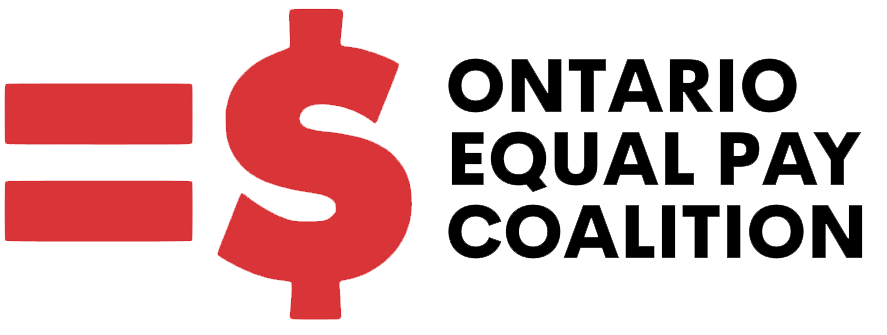Ontario’s Pay Equity Act requires that all public sector employers and all private sector employers with more than 10 employees achieve pay equity by eliminating sex-based wage discrimination and by continuing to maintain discrimination-free wages into the future.
Overview of the Pay Equity Act
Overview of the Act’s Purpose and Structure
- The Pay Equity Act was enacted in order to redress systemic sex-based wage discrimination in Ontario workplaces. The Act applies to all public sector employers and all private sector employers with more than ten employees, to all employees of these employers, and to their bargaining agents.
- Roughly speaking, the Act identifies the extent of pay inequity by comparing compensation paid to female job classes with those paid to male job classes of similar value.
- By design, pay equity is achieved through a process that is largely self-managed by the workplace parties. In unionized workplaces, the employer and bargaining agent negotiate with respect to defining the scope of the employer’s establishment, selecting a gender neutral comparison system for evaluating jobs, evaluating the jobs, selecting appropriate job comparators, preparing the pay equity plan, and maintaining the pay equity plan. In non-unionized workplaces, the employer prepares the pay equity plan but employees must have an opportunity to review the plan and recommend changes to the plan.
- There are two bodies which have roles in enforcing the Pay Equity Act: the Pay Equity commission, through its Review Officers and the Pay Equity Hearings Tribunal.
- Any disputes that arise out of the negotiation or preparation of a pay equity plan or problems with enforcement of the plan can be the subject of complaints to the Pay Equity Commission. Complaints are investigated by Review Officers of the Pay Equity Commission who can order the parties to take such steps as are necessary to prepare or implement the plan.
- Where an employer or a bargaining agent fails to comply with an order made by a Review Officer under section 24, a Review Officer may refer the matter to the Hearings Tribunal.
- Where a Review Officer makes an order under section 24, an employer or bargaining agent that has been named in an order may request a hearing before the Hearing Tribunal with respect to the order. Where the order was made following a complaint but the complaint has not been settled, the complainant may also request a hearing.
- The Hearings Tribunal shall also hold a hearing if a Review Officer is unable to effect the settlement of a complaint and has not made an order under s. 24(3).
- The Hearings Tribunal conducts a new hearing into the complaint and has broad power to make such orders as are necessary to ensure compliance with the Act.
- A pay equity plan applies to an “establishment”. An establishment consists of all the employees of an employer in a “geographic division” which is generally a county, territory or regional municipality as described in the Territorial Division Act.
- The parties, however, can negotiate a broader identification of an establishment. The parties can agree to a central pay equity plan that covers multiple employers and multiple bargaining agents across two or more geographic divisions.
- The parties must identify which jobs classes in an establishment are done primarily by women and which are done primarily by men. A “job class” is made up of positions with similar duties and responsibilities. The workplace parties can negotiate the scope of positions which will constitute a job class. A “female job class” is one in which 70 percent or more of the members are female. A “male job class” is one in which 70 percent or more of the members are male.
- The job classes are then evaluated using a “gender neutral comparison system”. This means that the value of the work is measured using a composite of the skill, effort, responsibility and working conditions required by the job.
- The female job classes are then compared to male job classes of comparable value using the mechanisms identified in the Act.If the workplace is unionized, the comparison first takes place between male and female job classes within the bargaining unit. If there is no male job class of comparable value within the bargaining unit, the female job class is compared to a male job class of similar value anywhere else at the establishment. If the workplace is not unionized, the search takes place first between non-unionized jobs. If no male job of comparable value is found here, a non-unionized female job can be compared to male job classes in the bargaining unit.
- Where the wage paid to a female job class is lower than that paid to its male comparator, pay equity is achieved by adjusting the female wage so it is at least equal to the male wage. The amount by which the female wage must be increased to achieve pay equity is usually referred to as the “pay equity adjustment”.
- Where the workplace is unionized, the workplace parties negotiate and sign documents known as “pay equity plans”. Where the workplace is not unionized the employer is responsible for preparing the pay equity plan and employees are entitled to review and recommend changes to the plan.
- A pay equity plan includes information such as the system used to evaluate jobs, the method of comparison used, and a list of the job classes which formed the basis of the comparisons. It also sets out the result of that comparison and identifies the extent to which the wages of any female job classes must be adjusted to achieve pay equity. The plan also includes a schedule of when the pay equity adjustments will be paid out.
- Pay equity adjustments required under pay equity plans are phased in gradually. Each year, the employer must devote an amount equal to at least 1% of its annual payroll towards increasing the wages of those female job classes which are entitled to a pay equity adjustment.
- In a unionized workplace, the pay equity adjustments required by a pay equity plan shall be incorporated into and form part of the relevant collective agreements.
- After the pay equity plans are in place, the Act provides that pay equity must be “maintained”, that is the employer must maintain compensation practices that provide for pay equity and not allow the compensation gap to widen again.
- The Act permits parties to amend pay equity plans in response to changed circumstances. However, any amendment to the pay equity plan must be negotiated between the employer and the bargaining agent. If the parties are unable to agree to amendments, they must notify the Pay Equity Commission. If the workplace is not unionized, the employer can amend the plan and, if they disagree with the changes, the employees are entitled to file an objection to the amendment with the Pay Equity Commission. In the event of a failure to agree or an objection, a Review Officer of the Pay Equity Commission will investigate and endeavour to effect a settlement or, if necessary, make an order deciding the outstanding issues.
Methods of Comparison
Not all workplaces are structured the same: some have both male and female job classes, others have few male job classes and some have no male job classes. Therefore, the Act outlines three different wage comparison mechanisms which are tailored to suit different kinds of workplaces. These mechanisms are:
- Job-to-job comparison
Job-to-job comparison is used when a single establishment has both male and female job classes and the female job classes can be matched up with male job classes of equal or comparable value.If the female job class is paid less than the comparable male job class, the wages of the female job class must be raised so that they are at least equal to the male wages.Employers using the job-to-job comparison method phase in pay equity incrementally. Each year, they must devote at least 1% of their annual payroll towards closing the gap. Public sector employers using this mechanism must close the entire wage gap by January 1, 1998. - Proportional value comparison
Proportional value comparison is used when an establishment has both female and male job classes but the job-to-job comparison method cannot be used because a female job class cannot be matched to a male job class of equal or comparable value.Under Proportional value comparison, the female job class is compared to a “representative group of male job classes”. To establish this representative group, the male job classes are plotted on a graph which measures the wage rate on the vertical axis and the value of the job on the horizontal axis. A “male wage line” is constructed, either by drawing it free-hand on the graph or by using the statistical method called regression analysis. The female job classes are then plotted on the graph. If they fall below the male wage line, the wage rate for the female job class must be increased by the amount necessary to bring it up to the line.Again the pay equity adjustments are phased in gradually. Each year the employer must devote at least 1% of its annual payroll towards closing the wage gap. Public sector employers using this method must close the entire wage gap by January 1, 1998. - Proxy comparison
The proxy comparison method is set out in Part III.2 of the Pay Equity Act. The proxy comparison method applies only to public sector employers which either have no male job classes or which do not have enough male job classes to construct a male wage line using the proportional value comparison method. The list of public sector employers which are subject to the Act is set out in the Schedule to the Act.Before the proxy comparison method can be used, the employer must notify the Pay Equity Commission that it was unable to achieve pay equity using either the job-to-job or proportional value comparison methods. A Review Officer at the Pay Equity Commission must then investigate to confirm that the employer cannot use the job-to-job or proportional value methods and that the employer is a public sector employer eligible to use the proxy method. If these criteria are satisfied, the Review Officer issues a Proxy Order declaring the employer to be eligible to use the method. This employer is then known as a “seeking employer”.Under the Proxy comparison method, the seeking employer is matched with a “proxy employer” which has already negotiated a pay equity plan. The “seeking employer” borrows wage and job value information from the “proxy employer” to conduct its job comparisons. The “proxy employer” is another public sector employer whose business is similar in nature to that of the seeking employer but which has male job classes. Which kind of organization will be used as the appropriate proxy employer in any particular case is designated in Ontario Regulation 396/93.The seeking employer identifies its “key female job classes” which are the female job classes with the greatest number of employees or the female job classes whose duties are essential to the delivery of the service provided by the employer. The seeking employer then requests wage and job information from the proxy employer regarding its female job classes whose duties and responsibilities are similar to those of the key female job classes.
As indicated above, the female job classes at the proxy employer have already had their wages adjusted to achieve pay equity. Therefore, to achieve pay equity, the female job classes at the seeking employer are compared to similar female job classes at the proxy employer. For example, a health care aide at a nursing home is compared to health care aide at a home for the aged whose wages have already been adjusted to a pay equity rate.
Following the same graphing process as the proportional value method, wage and job value information for the proxy employer’s female job classes is used to construct a wage line representing non-discriminatory wages. The seeking female job classes are then plotted against the wage line. Where the seeking female job classes fall below the line, their wages are increased to the line.
Wage adjustments under proxy pay equity plans are retroactive to January 1, 1994.
Pay equity adjustments required under proxy pay equity plans are also phased in gradually. Each year the employer must devote at least 1% of its annual payroll towards closing the wage gap. However, unlike public sector employers using the job-to-job or proportional value comparison methods, there is no end date by which pay equity must be achieved under the proxy method. The pay equity adjustments will be phased in at a rate of 1% of payroll each year over as many years as are needed to close the gap.




